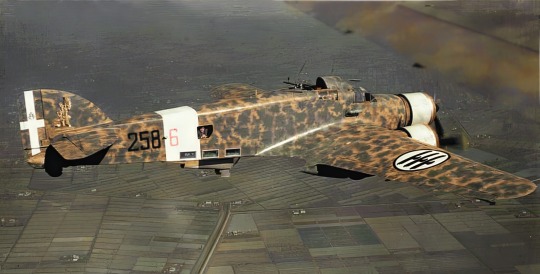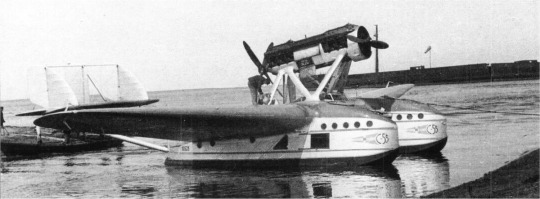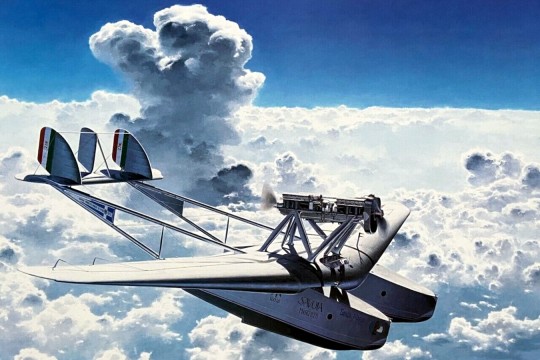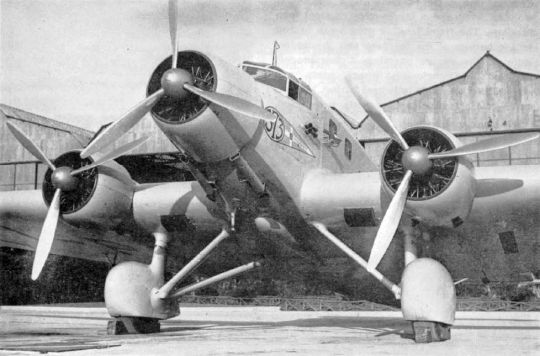#Savoia Marchetti
Explore tagged Tumblr posts
Text

The Italian Savoia Marchetti SM-79 Sparviero based in Castelvetrano, Sicily. Maximum speed: 290 mph (460 km/h) at 12,430 ft (3,790 m)
#aircraft#airplane#ww2#wwii#aviation#military#dronescapes#savoia marchetti#italy#sicilia#sicily#sparviero#sm-79#castelvetrano#italian aircraft#italian plane#aviation history#aviation photography#colorized#vintage photography
163 notes
·
View notes
Text

Savoia-Marchetti S.74, Italian four-engine airliner on a vintage postcard
#postcard#ansichtskarte#briefkaart#photography#carte postale#vintage#marchetti#postkarte#italian#photo#historic#s.74#postkaart#ephemera#postal#airliner#sepia#savoia#engine#four#tarjeta#savoia-marchetti
18 notes
·
View notes
Photo

Savoia-Marchetti SM.79 Sparviero
146 notes
·
View notes
Text

Hydravion Savoia-Marchetti S.55P de l'Aeroflot – 1933
#avant-guerre#pre-war#aviation civile#civil aviation#aeroflot#hydravion#flying boat#Savoia-Marchetti S.55#S.55#1933
20 notes
·
View notes
Text
Far vedere i sorci verdi.


“Tre topi verdi” dipinti sulla fusoliera color rosso fuoco di ogni aereo era il marchio che caratterizzava la 205° Squadriglia da Bombardamento appartenete al 12° Stormo dell’Aeronautica Militare Italiana, per questo motivo denominata la Squadriglia dei “Sorci Verdi”. Era il 1936 e quello fu il primo reparto che ebbe in dotazione i famosi trimotori Savoia-Marchetti. In breve i “Sorci Verdi” divennero famosi a livello internazionale sia per le intrepide trasvolate e le numerose manifestazioni sportive, sia per le valorose missioni di guerra, al punto che tra la popolazione venne in voga il modo di dire “vi faremo vedere i sorci verdi!” Oggi questa espressione viene comunemente usata quando si vuole impressionare qualcuno o dargli del filo da torcere, o quando si vuole battere o sopraffare un avversario umiliandolo e sorprendendolo con un’azione inaspettata e risolutiva. (da ADAGI ALLEGRI ANDANTI di Franco Ciarleglio, Sarnus Editore)

Franco Ciarleglio Read the full article
0 notes
Text

Italian Air Force Savoia-Marchetti at the Vigna di Valle - Italian AF Museum
@ron_eisele via X
#sm.72 sparravio#reggia aeronautica#torpedo bomber#aircraft#ww2#aviation#aviation military pics#aviation military#military aviation#military aircraft#military
66 notes
·
View notes
Text

Italian Savoia-Marchetti SM.79 Sparviero (Hawk) bomber flies over the sea convoy (steamer Caffaro, damaged destroyer Polluce, steamer Nirvo, and torpediniera Cigno (Swan)) on the way from Tripoli to Naples
#youtube#aircraft#airplane#aviation#dronescapes#military#ww2#documentary#wwii#Savoia Marchetti#Bomber#italy#tripoli#napoli#naples
22 notes
·
View notes
Text

1940 Malta Savoia Marchetti SM79 - Mark Postlethwaite
During the morning on 17 August, the Mediterranean Fleet was out for a raid in support of the Army. The battleships HMS Warspite, HMS Ramilles and HMS Malaya, supported by the cruiser HMS Kent and three flotillas of destroyers bombarded Bardia harbour and Fort Capuzzo, starting at 06:45 and continuing for 22 minutes. As the vessels headed back towards Alexandria a series of bombing attacks were launched against them by the Regia Aeronautica.The RAF and the FAA provided escort for the fleet. HMS Eagle's Fighter Flight of three Sea Gladiators had been flown to Sidi Barrani airfield in Libya, and from here patrolled over the Fleet. 'B' and 'C' Flights of 80 Squadron provided air support with flights of four Gladiators over the ships from dawn to dusk. ‘A’ Flight of 112 Squadron was positioned at Z Landing Ground (Matruh West) while ‘C’ Flight of 112 Squadron was based at Y LG about 18 kilometres further west and they also took part in the covering missions.The attacks on the Royal Navy began when, at 10:40 five SM 79s were seen at 12,000 feet, heading in from the north-east. Over the fleet there were, on standing patrol, at least the Gladiators of ‘A’ Flight 112 Squadron (probably six of them), the three Sea Gladiators of HMS Eagle’s Fighter Flight and a single Hurricane from ‘A’ Flight 80 Squadron flown by Flying Officer John Lapsley (P2641). They intercepted the Italian bombers and altogether claimed six of them (…)
John Lapsley told a newspaper about this combat:“I arrived just as five S 79’s had dropped their bombs, all well astern of the fleet, and were making off. One immediately went down in flames – evidently hit by anti-aircraft fire from the battleships. I picked on the leader and gave him about eight short bursts. He fell away, obviously in difficulties. Actually he landed his aircraft in our lines – there were six hundred bullet holes in it [probably ’56-9’ flown by Tenente Lauchard of the 56a Squadriglia].Then I picked on another and had just got a second burst into him he went up in flames. I was about one hundred yards away and the planes were much too close for comfort so I swerved away just as the crew of the S 79 ‘baled out’.The third remaining S 79 by this time was quite close to the coast and he was diving like mad for a cloud. I gave him three or four long bursts, and with one engine smoking he disappeared. I think he went into ‘the drink’.These Italian aircraft seem to be built of ply-wood. At any rate you have to dodge the pieces that come flying back at you when you fire your guns.There didn’t seem to be much more doing, so I came home. Even then I had some ammunition left.(…
) The third to be shot down was ’56-9’ flown by Tenente Arturo Lauchard of the 56a Squadriglia, which was seriously damaged. With all the crew dead inside the second pilot Tenente Vittorio Cèard (Lauchard was wounded) made a forced landing on a beach. The beach was in Egyptian territory and the two pilots were taken prisoners. The plane of Lauchard was later recovered and, taken to Alexandria, was exposed as a war prize on Ismailia Square. Lauchard left a realistic narration of his capture where he told that he was transported to the airport of Sidi Barrani where he was taken to the Officer’s Mess where an Intelligence Officer examined him. Lauchard told him only his name and rank and the amused British Officer showed him a chart where all the units of Regia Aeronautica were recorded with airbase, number of planes and names of the crew chiefs. There his name already was, written on a tag that the Intelligence Officer removed. Later the RAF officers offered a drink to him and he met a young Flight Lieutenant that around ten days before had been shot down by Italian fighters and obliged to bale out. The British pilot told Lauchard that while descending in his parachute an Italian fighter pointed on him but instead of opening fire he passed near him weaving with his arm. It seems that the pilot was almost surely Flight Lieutenant 'Pat' Pattle.
source:
31 notes
·
View notes
Text

Savoia-Marchetti SM.79 Sparviero (Sparrowhawk) at the Vigna di Valle - Italian AF Museum. For more, see my Facebook group - Eagles Of The Reich
25 notes
·
View notes
Text

Savoia-Marchetti SM.79 Sparviero (Sparrowhawk) at the Vigna di Valle.
27 notes
·
View notes
Text

1927 Savoia-Marchetti SM 55 'Santa Maria' - Shigeo Koike
The head of the Italian government Benito Mussolini suggested that the colonel of the Regia Aeronautica Francesco de Pinedo, famous aviator for his solo raid Rome-Australia-Tokyo-Rome in 1925, made a flight to the Western hemisphere to inspire pride in the population of Italian descent who had emigrated to the Americas. This idea became the "Four Continents" flight of 1927, intended to demonstrate the ability of a flying boat to fly from Italy to Africa and cross the Atlantic Ocean to Brazil followed by several stops in South America and the Caribbean, a tour of the United States and Canada, and a transatlantic flight back to Europe that finally ended in Rome. Pinedo's pilots, Captain Carlo Del Prete, and flight engineer Vitale Zacchetti took off on February 13, 1927 from Cagliari, Sardinia, in an S.55 and headed west across the South Atlantic. Four months later, on June 16, 1927, the seaplane landed in the port of Ostia having traveled 46960 km (29180 miles) in 193 hours of flight and made more than 50 stops.
On 20 June 1928 Savoia-Marchetti S.55 I-SAAT Santa Maria, piloted by Ten. Col. Umberto Maddalena of the Italian air force, located survivors of Arctic explorer Umberto Nobile's crashed airship Italia on an ice floe about 120 km (75 mi) northeast of Nordaustlandet, Svalbard.
15 notes
·
View notes
Photo

The Italian Style...
Italo Balbo leaning to the side of a Savoia Marchetti SM 55 with some Royal Italian Air Force Officers.
Orbetello Base,1933.
24 notes
·
View notes




